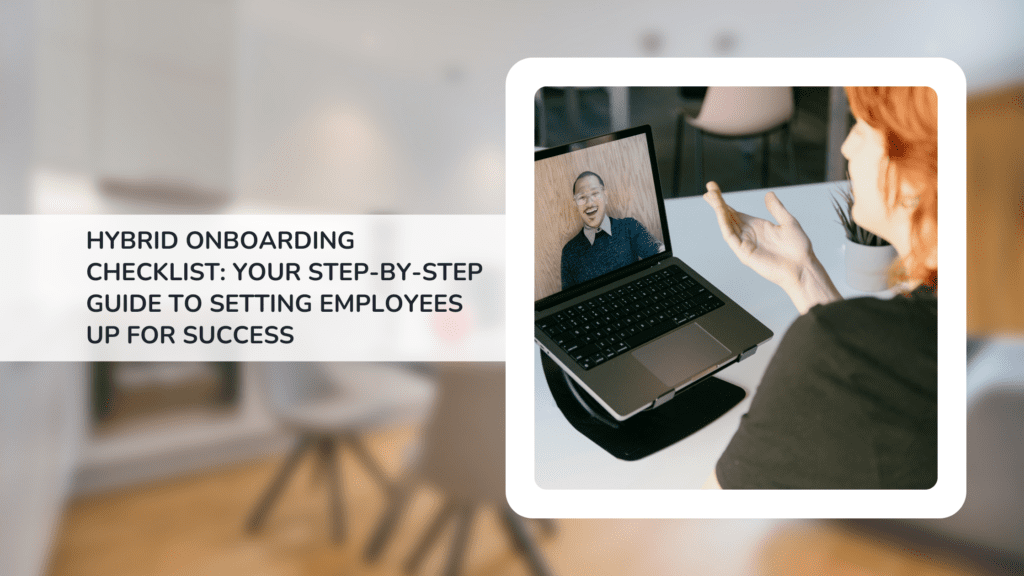
You can drive tangible business results by taking a vested interest in your team.
What’s the most important thing for your business? Financial growth? Customer experience? Offering the best possible product or service? If you said yes to any of those, you’re certainly not wrong. But there’s one thing which is equally important: human capital.
In fact, a recent HR Certification Institute survey of 300 C-Suite executives found that 95% agree their ability to retain great talent directly affects their company’s bottom line. And that’s because, even in the face of growing opportunities for automation in the workplace, it’s a company’s employees who are responsible for doing the work that will drive its success.
Interestingly, though, that same survey also found that only 59% of respondents feel their company is doing an adequate job of retaining staff.
But here’s the good news: as a leader, you can take a major role in retaining your talent. And it all starts with mastering the art of managing people.
This isn’t always an easy task. Every team is comprised of a unique and diverse group of people and personalities. But there are some key tactics you can put into place and habits you can work to develop to ensure you’re the best possible people-manager you can be. Read on to find out how to do so by:
- Actively Increasing Emotional Intelligence
- Getting to Know Your Team
- Becoming an Expert in Conflict Resolution
- Committing to Creating a Great Company Culture
- Learning to Offer Productive Feedback
- Learning to Motivate and Inspire
Actively Increasing Emotional Intelligence

Emotional Intelligence (otherwise known as EQ) refers to your ability to perceive and manage both your own emotions and the emotions of others, as well the ability to harness those emotions and apply them to tasks like thinking and problem-solving. Since almost all jobs involve working with people in some capacity, EQ is a critical skill – particularly for leaders. In fact, EQ has been linked to boosts in And luckily, it’s a skill that can be honed and developed. Here are a few ways to approach increasing emotional intelligence:
Understand EQ
To effectively improve your EQ, you need to understand exactly what it entails. Emotional Intelligence is generally categorized into five core components:
- Self-awareness – Being self-aware means knowing how you feel, and how your emotions and actions affect those around you. In a leadership role, this also means having a clear picture of your strengths and weaknesses.
- Self-regulation – This boils down to staying in control of your emotions. Leaders who are adept at self-regulating rarely verbally attack others, make rushed or emotional decisions, stereotype people, or compromise their values.
- Motivation – Self-motivated leaders work consistently toward their goals and have extremely high standards for the quality of their work.
- Empathy – As a leader, having empathy is critical in your ability to manage a successful team or organization. In fact, according to a survey by Businessolver, 92% of employees believe showing empathy is an important way to advance employee retention. Empathetic leaders have the ability to put themselves in someone else’s shoes. They help develop their people, challenge others who are acting unfairly, , and listen to those who need it.
- Social skills – Leaders with great social skills also tend to be great communicators. They lead by example, are open to hearing both good and bad news, and are experts in getting their team to support them and be excited about a new mission or project. They are great at managing change and resolving conflicts diplomatically.
By gaining an understanding of the factors that play into emotional intelligence, you’ll be more suitably equipped to hone it.

Work to be Aware of Your Emotions
Moods are contagious – particularly in leaders. As a leader, the mood you bring to the office is almost guaranteed to have an impact on your team. Do your best to be self-aware: make a mental note of your moods and keep track of how frequently you’re in a good mood versus a bad mood.
Conduct frequent temperature checks on yourself. Are you feeling happy and enlightened? Or are you feeling tense and frustrated? Once you’ve evaluated this, exercise your empathy and think of how your current mood will impact those around you. When you’re in a bad mood, it’s probably not the best time to do a performance review with a team member. It’s important to understand how to go about dealing with your emotions. For instance, if you’re in a bad mood, do something to mitigate it – take a walk, take some deep breaths, whatever it may be.
Implement Proactive Listening
In order to be empathetic, you need to learn to truly listen. In fact, according to Ultimate Software, 75% of employees would stay at an organization that listens to and addresses their concerns. Often times, we’re so focused on waiting for our turn to talk that we neglect to listen intently and proactively to others. Here are a few proactive listening tricks you can implement in your conversation:
- Strive to Learn: Instead of approaching the conversation wanting to tell and inform, approach it with the goal of learning. Think of the person you’re speaking with as somebody who can teach you something.
- Focus on the Speaker: Force yourself to actually listen to what you’re hearing. Avoid multitasking at all costs and actively suppress the urge to think about what you’re going to say next.
- Drill Down to the Details: Don’t just scratch the surface. Get all available details. Ask directive, specific questions that focus on the conversation – things like, “How did you come to this conclusion?” “How would this work?” Or, “Tell me more about…”
- Summarize and Fact Check: Reiterate points to drill them into your memory. Fact check things you feel unclear on or don’t understand. It’s important to make sure you’re on the same page with the person you’re speaking to. Follow up on points by asking things like, “Am I understanding correctly?” or “Can you confirm this is what you’re saying?”
Enlist a Coach
Training and coaching programs have been shown to boost EQ. The most successful programs often focus on the five components typically regarded as the core of emotional intelligence: self-awareness, self-regulation, motivation, empathy and social skills.
If you want to learn more about how to master emotional intelligence, we recommend looking into our Emotional Intelligence program, where you’ll learn to increase self-awareness, self-regulate behaviors, develop better social skills for leadership, use emotionally intelligent motivators, and develop a greater sense of empathy.
Getting to Know Your Team
It’s nearly impossible to be a great people manager if you don’t truly know the members of your team. And since no two people are the same, there simply is no cookie-cutter approach to managing employees. Being a great people manager means building a rapport with your team and earning their trust. You need to show them you genuinely care about them. A great step in doing this is to get a deep understanding of who they are, what interests them, what they find challenging, and what motivates them. Here are a few ways you can get to know your team:
Apply the 80/20 Rule: There’s a principle called the Pareto Principle – better known as the 80/20 rule – which states that 20% of our efforts affect 80% of the results. This principle is commonly applied to multiple areas of business, from project management and quality control to time management – and leadership. Try to dedicate 20% of your day to working more closely with your team, making yourself available and accessible, and taking the time to get to know them. This will help you become a mentor to them, and in turn allow you opportunities to help coach them on not only their professional goals, but their personal ones as well. While it’s not always feasible to dedicate 20% of your day to being with your team, showing that you’re making a real effort to be around and available them will go a long way in building trust and positioning you as somebody they can go to for anything.
Implement D.I.S.C. Assessments: If you want to get to know your colleagues in a profound way, then a D.I.S.C assessment is a great option for you. Based on the work of American psychologist Dr. William Moulton Marston, these self-assessments are designed to help individuals identify their strengths and weaknesses, especially within a team dynamic, and to provide context on how best to work with your team members. D.I.S.C. assesses people within on four “quadrants”:
- Dominance – People who rank high in this category tend to be more direct, results-driven, and strong-willed. They are often motivated by competition, challenges, and opportunities to pursue new things. They may come across as confident, determined, and possibly aggressive or demanding.
- Influence – Those with high “influence” scores are often outgoing, enthusiastic, optimistic, and enjoy working with others. They may be perceived as warm, popular, and flaky at times.
- Steadiness – Those who rank high in the “S” quadrant are generally patient, humble, and tactful. They really emphasize cooperation and taking a composed approach to their work. Their colleagues may say they’re supportive and reliable but can overthink and deliberate on things too long.
- Conscientiousness – People who skew towards this quadrant are generally more analytical, private, and systematic. They love to learn new things, exemplify their skillset, and do things “right.” They may be seen as detail-oriented and diplomatic, albeit a bit of a micro-manager at times.
D.I.S.C. assessments are a great way to help you become the best possible people manage. In addition to having your team take D.I.S.C. assessments, you can also take your own and share the results with them. This will show them you’re open, transparent, and putting in an active effort – in turn building trusting and creating an even stronger rapport.
We recently implemented D.I.S.C. assessments here at Outback Team Building & Training and it had a hugely positive effect on our team and our company. To learn more about D.I.S.C. assessments and if they might be right for you and your team, check out our free downloadable white paper: A Practical Guide to Using D.I.S.C. in the Workplace.
Becoming an Expert in Conflict Resolution

As a leader, the way you handle conflict has a direct correlation to the level of trust, respect and connection you will have with your team. And while most people do their best to avoid conflict, the nature of workplaces mean conflict is effectively unavoidable. Conflict resolution is an art. To master the art of conflict resolution, consider implementing these five tips:
- Disagree Using Questions Rather Than Firm Statements – In any conflict, the ability to soften the delivery of a differing opinion is key. Using guiding questions instead of firm, blunt statements is a great way to do this. When you disagree with an idea, consider asking for rationale and insight before presenting your opinion. This way, you’re respectfully engaging with the original idea and offering the opportunity for an explanation to be given, in turn showing that you’re willing to hear everyone out.
- Avoid Using Absolutes – There are few things more inflammatory in a conflict than telling somebody that they either “always” or “never” do something. Using these kinds of absolute terms will quickly put people on the defensive. In a conflict, stick to the facts and try to address only the issue at hand. If there’s a consistent behavior that needs to be addressed, consider approaching it as something that happens often enough to be noticed rather than something that always happens.
- Offer Solutions – People often react negatively to having their ideas challenged or shot down. And while disagreements with regards to ideas or actions are often at the core of workplace conflicts, there’s a strategic way to voice your opinion: offering solutions in tandem with your challenge. By doing so, you’re proactively letting the other parties involved know that you’re engaged and enthusiastic about collaborating to find a suitable and appropriate outcome. Whether you’re involved in a conflict or working to mitigate one, this is an important part of the process.
- Make Sure Everybody Feels Heard – If a conflict ends but any party involved feels they haven’t been adequately heard, then it likely wasn’t entirely resolved. And unresolved conflicts are more likely to manifest themselves again later. Booking follow-up meetings with all parties is a great way to ensure there are no unresolved issues left on the table.
- Predict Conflicts – While many conflicts catch you off guard, you can apply a keen eye to your team in order to proactively identify signs of a potential conflict. Look for personality clashes and underlying tensions that could surface during a challenging moment and anticipate how you can handle them if they happen. Keeping an open line of communication and scheduling regular temperature check meetings with your team can also help you maintain visibility on team dynamics and potential issues.
At Outback Team Building & Training, we offer a program focused on Conflict Resolution which can help you change how you treat workplace conflicts, learn the value of taking accountability, recognize common conflict behaviors, use the conflict initiation model, and find new ways to manage conflicts.
Committing to Creating a Great Company Culture

In today’s job market, a great company culture isn’t a perk. It’s a necessity. Research by Deloitte found that 94% of executives and 88% of employees believe a distinct corporate culture is important to a business’ success. But according to a survey conducted by Gallup, only 30% of American employees are engaged with, enthusiastic about, and committed to their workplace.
This means that 70% of American workers aren’t showing up to work committed to delivering their best possible performance. Most startlingly of all, these disengaged employees are costing companies between $450 and $500 billion annually in the United States alone.
As a leader, a great company culture is key in successfully managing a team (to learn why check out our podcast interview with Tracey Topping, Employee Experience Manager at multinational tech company Left – which boats an impressive 97% retention rate). But there’s a silver lining. Creating a great company culture and doesn’t have to be hard. Even small improvements go a long way. Here are a few tactics you can implement starting now:
Activate a Corporate Social Responsibility Strategy
Have you ever heard somebody say that doing good is good for business? Well, it’s a fact. Research has shown that corporate social responsibility (CSR) is key to employee engagement. And while budgets are often among the greatest barriers for companies looking to activate a CSR strategy, the good news is that it can be done inexpensively and effectively. From creating a volunteer program that allows employees to volunteer during work hours to matching employees’ charitable donations, adopting green practices at the office, making small business loans to entrepreneurs in developing countries through organizations like Kiva, or doing a charitable company event, there are a ton of options at your disposal.
To learn more about how to create a great CSR strategy, check out our blog post: Everything Your Business Needs to Know About CSR.
Strive for Great Office Design
Offices are no longer just places where employees have to go to do work. Your office can actually that helps you increase productivity, enhance company culture and create overall happier employees. There are that can have a big impact on the happiness of your team and enhance company culture – from lighting and noise to ventilation, greenery and plant life, standing desks and ergonomic chairs, photos and art, common areas and flexible workspaces and even colors, tones and materials.
For more tips and tricks on how to create a great workspace for your team, check out our article: 50 Ways to Improve Your Office Environment.
Put an Emphasis on Employee Wellness
Healthy employees are happy and productive employees. In fact, a survey by Gallup revealed that unhealthy employees cost businesses around $153 billion in lost productivity every year. Even small things, like keeping healthy snacks readily available at the office and supporting regular fitness – like offering a corporate gym membership – can make a big impact.
Foster Social Connections
It’s nearly impossible to create a great company culture when employees barely know their colleagues. Team building events are a powerful way to help strengthen the. That’s why, at Outback Team Building & Training, we strive to build better relationships through memorable experiences. And best of all, they can be done on almost any budget. You can also consider hosting a company retreat in order to get your team together in a new and exciting environment. At Outback Team Building & Training, we host annual retreats so that our team members can connect in a meaningful way outside of the context of the office. We do something different each year to make sure it’s always fresh and exciting. It’s also a great idea to sprinkle in smaller, more frequent team social gatherings in between bigger events – whether it’s a quick team lunch, a weekly happy hour or even a company book club.
To learn more about how and where to throw outstanding company retreats, check out our two blog posts: Everything You Need to Know About Planning the Ultimate Company Retreat and The Top 20 Destinations in North America for Company Retreats.
Revisit and Reassess
The most important part of any great corporate culture is to understand that it will be an ongoing and ever-evolving process. You’ll need to revisit and reassess your approach from time to time to ensure it’s still effective. If some tactics seem to be less impactful than others, consider ways to tweak or replace them in order to continue improving. It’s also important to keep an open line of communication with your team, taking their feedback in stride and actioning it as necessary.
Creating a great company culture is an integral piece of the puzzle, but there are some other tactics you can put into play to drive a strong and successful organization. To learn more, check out our article: Actionable Habits and Tactics to Drive Leadership Success.
Learning to Offer Productive Feedback

In a leadership role, you’re responsible for the development of your team members. This means that giving productive, actionable feedback that actually helps people improve is a crucial skill. In fact, according to a survey by Workhuman, 89% of HR leaders agree that offering peer feedback and conducting regular check-ins have a positive impact on their organizations. Yet for many leaders, finessing their approach to can be difficult. To give the best and most effective feedback possible, make sure it checks these boxes:
- It’s Specific and Timely – When delivering feedback – whether positive or negative – it’s important that the feedback be specific and timely. It should have a clear business focus and should be discussed as soon as possible. If a colleague has done a great job, let them know you noticed right away. And if you need to discuss an issue with them, connect with them quickly so that they can adjust their behavior immediately rather than allowing them to continue in that pattern until their next formal review.
- It’s Direct – Never criticize a team member publicly. Doing so will only serve to embarrass the recipient of the feedback, in turn breaking their trust in you as a leader and making them feel alienated. Always connect with colleagues directly, on a one-on-one basis, in order to give feedback.
- It’s Unbiased – As a leader, it’s important that you’re able to remove ego from the equation and give feedback based solely on facts.
- It’s Goal-Oriented and Actionable – The biggest factor that distinguishes between effective and ineffective feedback is an actionable goal being associated with it. When giving feedback, it’s important to remind the recipient of the goal they’re ultimately striving towards and how their action either contributed to their fulfillment of that goal or detracted from it.
- It Comes with Solutions and Tools – Once you’ve provided your actionable feedback, offer additional support for your team member through tangible solutions and the provision of any necessary tools required to move forward. Doing so allows them to walk away from your meeting with a clear understanding of what needs to be done and how they will do it.
- It Ends on a Positive Note – Just as important as delivering the feedback effectively is ensuring the recipient walks away feeling as positive as possible. Delivering tough feedback and then letting them walk away feeling discouraged doesn’t bode well for the chances of them actioning it. On the other hand, if they walk away feeling inspired – both to improve and by you as a leader – you can bet they’ll work double time to implement the necessary changes.
- It’s Two-Way – Encourage an open dialogue when giving feedback and allow your team member to speak up if they have questions or require further context. You should also ensure they feel comfortable following up with you after the initial meeting. This way, they’ll be able to troubleshoot as they need to, and it will also give you visibility into whether the feedback was received and implemented.
To learn more about how to give productive and actionable feedback, check out our Performance Management Fundamentals program which will teach you the performance management cycle, how to build performance-driven relationships, how to coach colleagues more effectively, and how to measure performance more accurately.
Learning to Motivate and Inspire
Part of being a people manager is encouraging people to feel comfortable following your lead. That means it’s important for you to come across as confident – even if you don’t always feel it! Luckily, there are some subtle tweaks you can make to help you project confidence and own the room. Take a look:
Keep a Success Log
Believe it or not, competence into confidence. Sometimes, even the greatest leaders could use a reminder of their strengths. One great way to build confidence is to keep a success log – whether it’s emails congratulating you on successes, or a personal list of proud moments. That way, if you’re ever heading into a situation that makes you feel less than confident, you can take a look at your success log and draw up the confidence you felt in those moments.
Speak Concisely
If you want to project confidence, eliminate jargon from your vocabulary. Long, convoluted sentences and jargon don’t make you sound smarter. In fact, they often have the opposite effect. According to Nobel prize-winning psychologist Daniel Kahneman, using simple words doesn’t dumb down your message. It actually makes you appear more credible by demonstrating that you can articulate complex ideas in simple language.
Be Mindful of Posture, Gestures and Body Language
Sometimes, the simplest and most subtle cues can be the downfall of your air of confidence. Here are a few key things to mindful of:
- Things like fidgeting and a lack of sustained eye contact can give the appearance of being un-confident.
- Be mindful of your facial expressions and your hand motions. Try to avoid pointing, hand gestures with closed palms, or putting your hands on your hips. These can all give off an impression of agitation or impatience.
- Always maintain an assertive, open, positive, and receptive body In her famous Ted Talk, social psychologist Amy Cuddy suggested that our body language governs how we think and feel about ourselves and, in turn, how we hold our bodies can have an impact on our minds.
Become a Comfortable Presenter
You’ve probably heard that public speaking often ranks high on the list of peoples’ greatest fears. And that’s for good reason. The idea that your audience might reject you is scary. But as a leader, you need to be able to project confidence in any situation – especially when speaking in front of a group. Try these tactics next time you’re preparing for a presentation:
- Prepare Thoroughly: This goes without saying, but never walk into a presentation unprepared. It will show, and your presentation will flop. Take the time to sit down, read through the material, make notes, and set yourself cues to ensure you remember key points or things you want to emphasize.
- Don’t Just Memorize and Recite: There’s nothing less interesting than listening to somebody read a presentation from their slides. Your audience could do that by themselves. What matters most is your energy and enthusiasm. Focus on knowing the content inside and out and sharing it in your own words with your own passion.
- Rehearse with an Audience: Find somebody to rehearse with ahead of time – a friend, a colleague, whoever. A well-delivered presentation goes a long way in projecting confidence and owning the room.
- Go to Networking Events: This might not seem like a practical way to prepare for presentations, but you’re often asked to give quick elevator pitches at networking events. This is a great, inexpensive way to get comfortable speaking in front of people in a professional capacity.
- Listen to Great Speeches: One great way to help improve your public speaking is to listen intently to great speeches that have been made by people who are pros at it. American Rhetoric has a speech bank with more than 5,000 free speeches for you to listen to, including some from Martin Luther King Jr. and John F. Kennedy, among many others.
If you want to build your comfort as a presenter, check out our Impactful Presentation Skills program which can teach you to improve your core presentation skills, take advantage of speaking opportunities, become more comfortable when presenting, speak in public with confidence, and make a greater impact.
Want to Learn More About People Management Skills Development?
For more information about the personal and professional skills you can develop to become an even more effective leader, download your free copy of Actionable Habits and Tactics to Drive Leadership Success, or just reach out to our Employee Engagement Consultants.



